Leadership and Theory: Servant Leadership vs. Authentic Leadership
VerifiedAdded on 2023/03/17
|9
|2701
|35
Report
AI Summary
This report presents a comprehensive literature review comparing and contrasting servant leadership and authentic leadership. The paper begins with an introduction to both leadership styles, defining their core principles and characteristics. It then delves into a detailed comparison, highlighting the similarities and differences between servant and authentic leaders, including their approaches to employee motivation, ethical considerations, and organizational outcomes. The review incorporates scholarly articles to support the analysis, exploring how each leadership style impacts the workplace and the effectiveness of each leadership approach. The report concludes with a summary of the key findings, emphasizing the importance of understanding these leadership styles for achieving organizational goals and fostering a positive work environment.

Running head: Leadership and theory
Leadership and theory
Leadership and theory
Paraphrase This Document
Need a fresh take? Get an instant paraphrase of this document with our AI Paraphraser
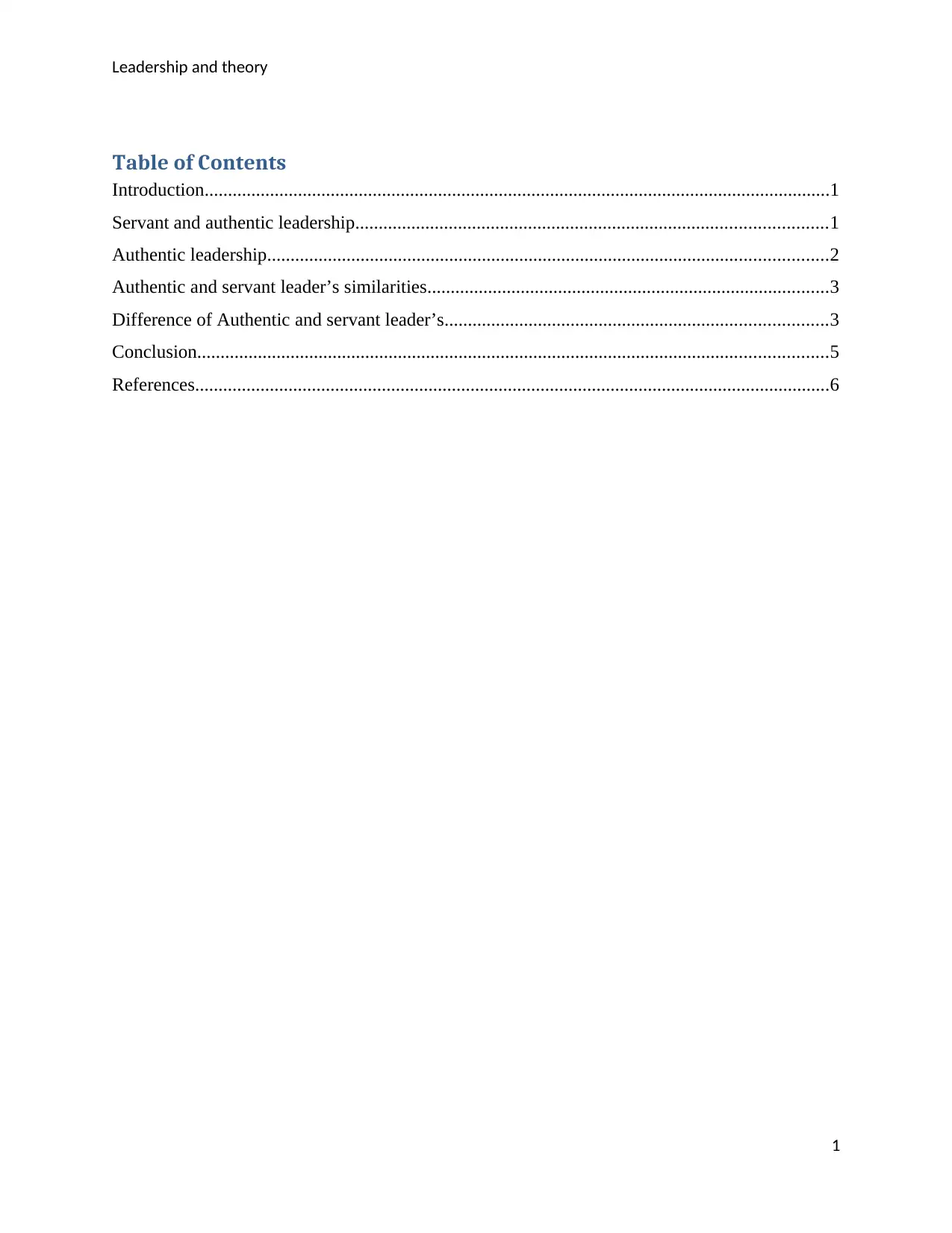
Leadership and theory
Table of Contents
Introduction......................................................................................................................................1
Servant and authentic leadership.....................................................................................................1
Authentic leadership........................................................................................................................2
Authentic and servant leader’s similarities......................................................................................3
Difference of Authentic and servant leader’s..................................................................................3
Conclusion.......................................................................................................................................5
References........................................................................................................................................6
1
Table of Contents
Introduction......................................................................................................................................1
Servant and authentic leadership.....................................................................................................1
Authentic leadership........................................................................................................................2
Authentic and servant leader’s similarities......................................................................................3
Difference of Authentic and servant leader’s..................................................................................3
Conclusion.......................................................................................................................................5
References........................................................................................................................................6
1

Leadership and theory
Introduction
In this paper the topic selected for the task is “Servant leadership and authentic leadership”. The
literature review will be based on this topic that will help in creating in-depth understanding of
both the leadership. These leaderships play an important role in the workplace as it guides the
employees to consider the right step which is beneficial for their growth. The leaders in the
workplace are the one who give guidance to the employees to consider the right step so that it
could be easy for the employees to give their best towards the goals and objectives of the
company.
Servant and authentic leadership
It has been stated by Afsar, Badir and Kiani (2016), that servant leadership is known as the
servant first. The leader who considers the servant leadership emphasizes on enriching the lives
of the individuals and also helps in completing the operational activities in an efficient manner.
The aim of the leader is to focus on serving the subordinates in the workplace. It can be stated
that servant leadership is not known as the leadership style or the technique but it is considered
as the way that can help the leaders to behave in a positive manner for the long time. In relation
to this, it is observed that they are problematic in terms of maintaining autocratic cultures but the
leaders have to make all the important decisions of the company.
The servant leaders also face the issue in earning respect which is important to be considered so
that operational functions of the business can be resolved. The servant leadership is concerned
with emphasizing on the requirements of the other but on the other hand the feelings of the
individuals are not considered. Servant leaders strive to consider the intentions of the other
people and also their perspective is considered. The servant leader can be empathetic but giving
their own view point on temporary basis but at last they have to value the perspective of the other
people that can help in approaching and dealing with the situations with the open mind. It has
been argued by Agote, Aramburu and Lines (2016), that servant leader considers persuasion
rather than the authority and also it encourage the individuals to consider the appropriate actions.
The leaders also focus on building the consensus in groups so that it could be easy for the people
to support the decisions.
2
Introduction
In this paper the topic selected for the task is “Servant leadership and authentic leadership”. The
literature review will be based on this topic that will help in creating in-depth understanding of
both the leadership. These leaderships play an important role in the workplace as it guides the
employees to consider the right step which is beneficial for their growth. The leaders in the
workplace are the one who give guidance to the employees to consider the right step so that it
could be easy for the employees to give their best towards the goals and objectives of the
company.
Servant and authentic leadership
It has been stated by Afsar, Badir and Kiani (2016), that servant leadership is known as the
servant first. The leader who considers the servant leadership emphasizes on enriching the lives
of the individuals and also helps in completing the operational activities in an efficient manner.
The aim of the leader is to focus on serving the subordinates in the workplace. It can be stated
that servant leadership is not known as the leadership style or the technique but it is considered
as the way that can help the leaders to behave in a positive manner for the long time. In relation
to this, it is observed that they are problematic in terms of maintaining autocratic cultures but the
leaders have to make all the important decisions of the company.
The servant leaders also face the issue in earning respect which is important to be considered so
that operational functions of the business can be resolved. The servant leadership is concerned
with emphasizing on the requirements of the other but on the other hand the feelings of the
individuals are not considered. Servant leaders strive to consider the intentions of the other
people and also their perspective is considered. The servant leader can be empathetic but giving
their own view point on temporary basis but at last they have to value the perspective of the other
people that can help in approaching and dealing with the situations with the open mind. It has
been argued by Agote, Aramburu and Lines (2016), that servant leader considers persuasion
rather than the authority and also it encourage the individuals to consider the appropriate actions.
The leaders also focus on building the consensus in groups so that it could be easy for the people
to support the decisions.
2
⊘ This is a preview!⊘
Do you want full access?
Subscribe today to unlock all pages.

Trusted by 1+ million students worldwide
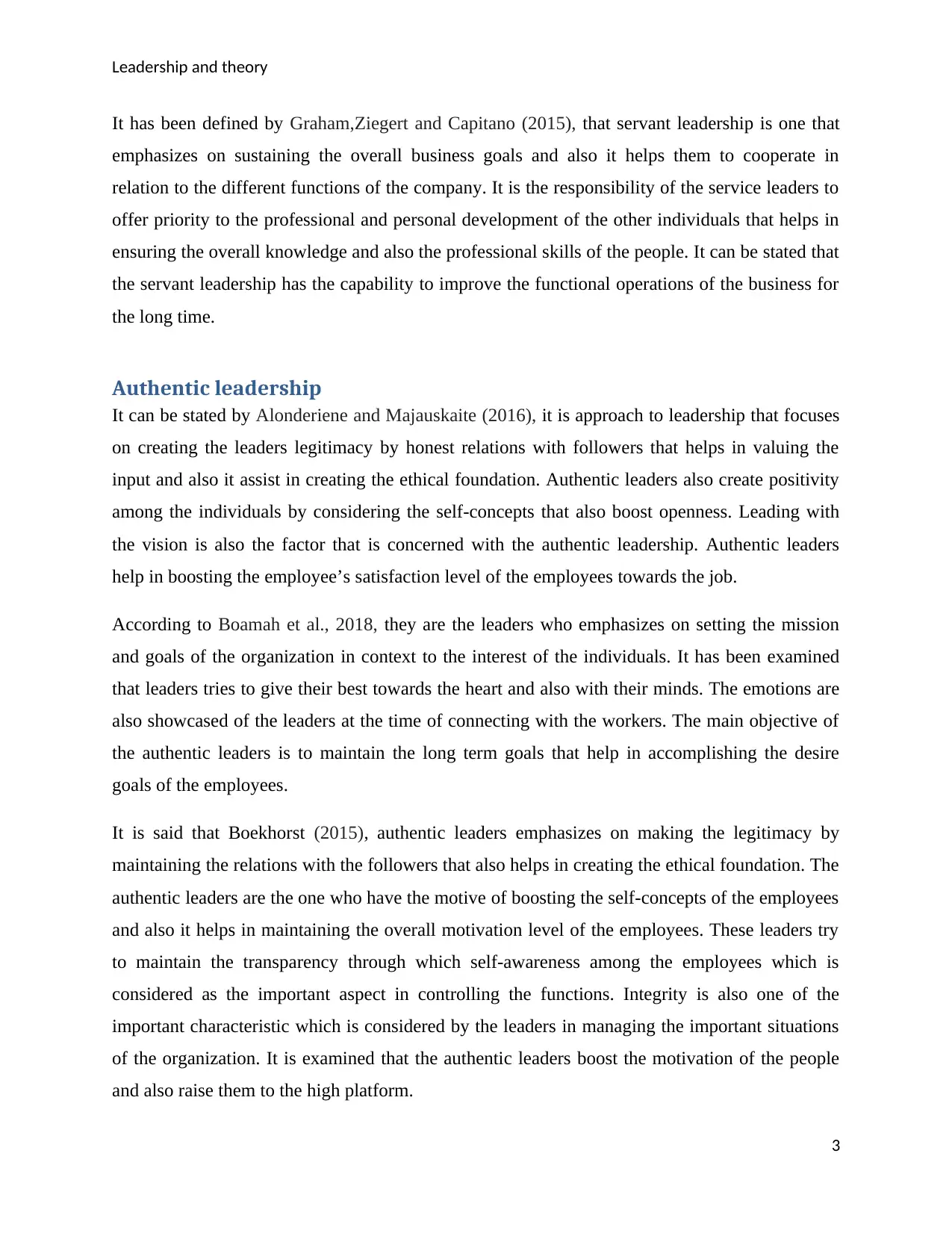
Leadership and theory
It has been defined by Graham,Ziegert and Capitano (2015), that servant leadership is one that
emphasizes on sustaining the overall business goals and also it helps them to cooperate in
relation to the different functions of the company. It is the responsibility of the service leaders to
offer priority to the professional and personal development of the other individuals that helps in
ensuring the overall knowledge and also the professional skills of the people. It can be stated that
the servant leadership has the capability to improve the functional operations of the business for
the long time.
Authentic leadership
It can be stated by Alonderiene and Majauskaite (2016), it is approach to leadership that focuses
on creating the leaders legitimacy by honest relations with followers that helps in valuing the
input and also it assist in creating the ethical foundation. Authentic leaders also create positivity
among the individuals by considering the self-concepts that also boost openness. Leading with
the vision is also the factor that is concerned with the authentic leadership. Authentic leaders
help in boosting the employee’s satisfaction level of the employees towards the job.
According to Boamah et al., 2018, they are the leaders who emphasizes on setting the mission
and goals of the organization in context to the interest of the individuals. It has been examined
that leaders tries to give their best towards the heart and also with their minds. The emotions are
also showcased of the leaders at the time of connecting with the workers. The main objective of
the authentic leaders is to maintain the long term goals that help in accomplishing the desire
goals of the employees.
It is said that Boekhorst (2015), authentic leaders emphasizes on making the legitimacy by
maintaining the relations with the followers that also helps in creating the ethical foundation. The
authentic leaders are the one who have the motive of boosting the self-concepts of the employees
and also it helps in maintaining the overall motivation level of the employees. These leaders try
to maintain the transparency through which self-awareness among the employees which is
considered as the important aspect in controlling the functions. Integrity is also one of the
important characteristic which is considered by the leaders in managing the important situations
of the organization. It is examined that the authentic leaders boost the motivation of the people
and also raise them to the high platform.
3
It has been defined by Graham,Ziegert and Capitano (2015), that servant leadership is one that
emphasizes on sustaining the overall business goals and also it helps them to cooperate in
relation to the different functions of the company. It is the responsibility of the service leaders to
offer priority to the professional and personal development of the other individuals that helps in
ensuring the overall knowledge and also the professional skills of the people. It can be stated that
the servant leadership has the capability to improve the functional operations of the business for
the long time.
Authentic leadership
It can be stated by Alonderiene and Majauskaite (2016), it is approach to leadership that focuses
on creating the leaders legitimacy by honest relations with followers that helps in valuing the
input and also it assist in creating the ethical foundation. Authentic leaders also create positivity
among the individuals by considering the self-concepts that also boost openness. Leading with
the vision is also the factor that is concerned with the authentic leadership. Authentic leaders
help in boosting the employee’s satisfaction level of the employees towards the job.
According to Boamah et al., 2018, they are the leaders who emphasizes on setting the mission
and goals of the organization in context to the interest of the individuals. It has been examined
that leaders tries to give their best towards the heart and also with their minds. The emotions are
also showcased of the leaders at the time of connecting with the workers. The main objective of
the authentic leaders is to maintain the long term goals that help in accomplishing the desire
goals of the employees.
It is said that Boekhorst (2015), authentic leaders emphasizes on making the legitimacy by
maintaining the relations with the followers that also helps in creating the ethical foundation. The
authentic leaders are the one who have the motive of boosting the self-concepts of the employees
and also it helps in maintaining the overall motivation level of the employees. These leaders try
to maintain the transparency through which self-awareness among the employees which is
considered as the important aspect in controlling the functions. Integrity is also one of the
important characteristic which is considered by the leaders in managing the important situations
of the organization. It is examined that the authentic leaders boost the motivation of the people
and also raise them to the high platform.
3
Paraphrase This Document
Need a fresh take? Get an instant paraphrase of this document with our AI Paraphraser
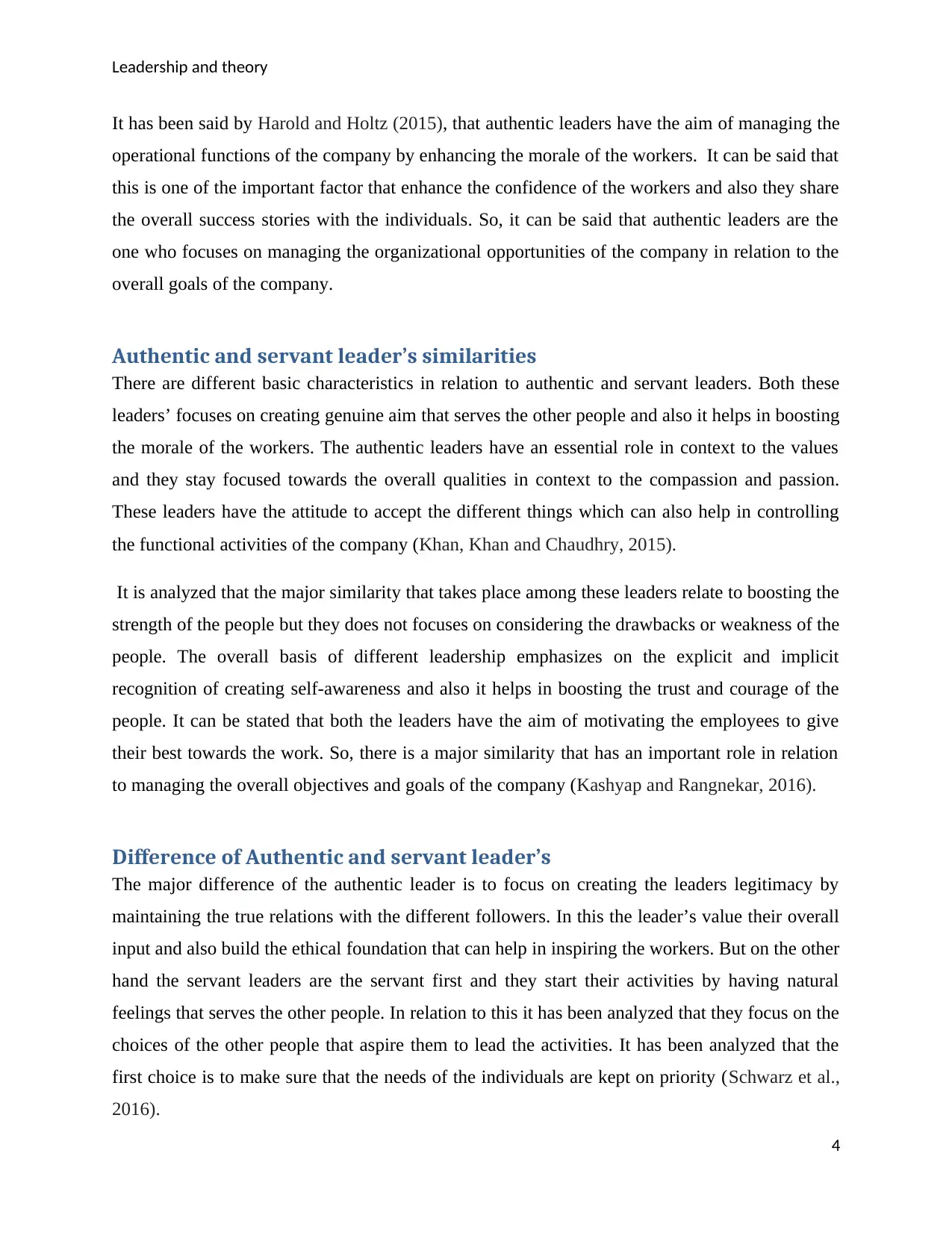
Leadership and theory
It has been said by Harold and Holtz (2015), that authentic leaders have the aim of managing the
operational functions of the company by enhancing the morale of the workers. It can be said that
this is one of the important factor that enhance the confidence of the workers and also they share
the overall success stories with the individuals. So, it can be said that authentic leaders are the
one who focuses on managing the organizational opportunities of the company in relation to the
overall goals of the company.
Authentic and servant leader’s similarities
There are different basic characteristics in relation to authentic and servant leaders. Both these
leaders’ focuses on creating genuine aim that serves the other people and also it helps in boosting
the morale of the workers. The authentic leaders have an essential role in context to the values
and they stay focused towards the overall qualities in context to the compassion and passion.
These leaders have the attitude to accept the different things which can also help in controlling
the functional activities of the company (Khan, Khan and Chaudhry, 2015).
It is analyzed that the major similarity that takes place among these leaders relate to boosting the
strength of the people but they does not focuses on considering the drawbacks or weakness of the
people. The overall basis of different leadership emphasizes on the explicit and implicit
recognition of creating self-awareness and also it helps in boosting the trust and courage of the
people. It can be stated that both the leaders have the aim of motivating the employees to give
their best towards the work. So, there is a major similarity that has an important role in relation
to managing the overall objectives and goals of the company (Kashyap and Rangnekar, 2016).
Difference of Authentic and servant leader’s
The major difference of the authentic leader is to focus on creating the leaders legitimacy by
maintaining the true relations with the different followers. In this the leader’s value their overall
input and also build the ethical foundation that can help in inspiring the workers. But on the other
hand the servant leaders are the servant first and they start their activities by having natural
feelings that serves the other people. In relation to this it has been analyzed that they focus on the
choices of the other people that aspire them to lead the activities. It has been analyzed that the
first choice is to make sure that the needs of the individuals are kept on priority (Schwarz et al.,
2016).
4
It has been said by Harold and Holtz (2015), that authentic leaders have the aim of managing the
operational functions of the company by enhancing the morale of the workers. It can be said that
this is one of the important factor that enhance the confidence of the workers and also they share
the overall success stories with the individuals. So, it can be said that authentic leaders are the
one who focuses on managing the organizational opportunities of the company in relation to the
overall goals of the company.
Authentic and servant leader’s similarities
There are different basic characteristics in relation to authentic and servant leaders. Both these
leaders’ focuses on creating genuine aim that serves the other people and also it helps in boosting
the morale of the workers. The authentic leaders have an essential role in context to the values
and they stay focused towards the overall qualities in context to the compassion and passion.
These leaders have the attitude to accept the different things which can also help in controlling
the functional activities of the company (Khan, Khan and Chaudhry, 2015).
It is analyzed that the major similarity that takes place among these leaders relate to boosting the
strength of the people but they does not focuses on considering the drawbacks or weakness of the
people. The overall basis of different leadership emphasizes on the explicit and implicit
recognition of creating self-awareness and also it helps in boosting the trust and courage of the
people. It can be stated that both the leaders have the aim of motivating the employees to give
their best towards the work. So, there is a major similarity that has an important role in relation
to managing the overall objectives and goals of the company (Kashyap and Rangnekar, 2016).
Difference of Authentic and servant leader’s
The major difference of the authentic leader is to focus on creating the leaders legitimacy by
maintaining the true relations with the different followers. In this the leader’s value their overall
input and also build the ethical foundation that can help in inspiring the workers. But on the other
hand the servant leaders are the servant first and they start their activities by having natural
feelings that serves the other people. In relation to this it has been analyzed that they focus on the
choices of the other people that aspire them to lead the activities. It has been analyzed that the
first choice is to make sure that the needs of the individuals are kept on priority (Schwarz et al.,
2016).
4

Leadership and theory
The authentic leadership also relates with the emerging response that takes place in relation to
the demand of the society. They have the aim of boosting the trust and also good leadership
among the workers. There are various characteristics that are concerned with these leaders such
as they have the attitude of creating self-awareness and also they emphasizes on the balanced
processing that helps in boosting the transparency in the overall working stricture of the
company. But on the other hand it can be noticed that the servant leader are involved actively in
the activities of the company and also they have different characteristics such as they focus more
on the views of the people and also they consider the approach concerned with empathy (Nielsen
et al., 2016).
In relation to the overall factors, behavior is also one of the important factors that is important to
be considered by the leaders. It has been analyzed that authentic have confidence that serves as
the inspiration of the employees and also it helps in boosting the positivity in context to the
different functions of the company. If compared with servant leadership it can be seen that it is
one of the multi-dimensional approach that focuses on the behavior of the employees in relation
to healing and also they behave in an ethical manner. It is one of the leadership that helps in
empowering the followers to be efficient towards the work and it also creates the value for the
overall community (Smith, 2015).
The authentic leaders also emphasizes on the outcome of the followers in which it helps in
creating the trust that can help in creating the positive future outcomes. The servant leaders are
the one who focuses on maintaining the overall outcome related with creating the high
engagement and also it assist in maintaining the commitment level of the employees towards the
assigned work. The overall team outcome helps in attaining the positive response in context to
the identification of the group and also they maintain the equal climate for the employees in
which the equal chance is offered to the employees. So, it can be stated that this is one of the
important factor that helps in maintaining the positive response in relation to the overall
outcome. The affect upon the followers is concerned with the satisfaction and also commitment
but on the other hand the servant leadership focuses on job involvement and also it helps in
creating the positive environment in the workplace (Wang and Sung, 2016).
It can be examined that there are various limitation in context to authentic leadership as it has
been analyzed that it focuses on the different stages of development and also it helps in attaining
5
The authentic leadership also relates with the emerging response that takes place in relation to
the demand of the society. They have the aim of boosting the trust and also good leadership
among the workers. There are various characteristics that are concerned with these leaders such
as they have the attitude of creating self-awareness and also they emphasizes on the balanced
processing that helps in boosting the transparency in the overall working stricture of the
company. But on the other hand it can be noticed that the servant leader are involved actively in
the activities of the company and also they have different characteristics such as they focus more
on the views of the people and also they consider the approach concerned with empathy (Nielsen
et al., 2016).
In relation to the overall factors, behavior is also one of the important factors that is important to
be considered by the leaders. It has been analyzed that authentic have confidence that serves as
the inspiration of the employees and also it helps in boosting the positivity in context to the
different functions of the company. If compared with servant leadership it can be seen that it is
one of the multi-dimensional approach that focuses on the behavior of the employees in relation
to healing and also they behave in an ethical manner. It is one of the leadership that helps in
empowering the followers to be efficient towards the work and it also creates the value for the
overall community (Smith, 2015).
The authentic leaders also emphasizes on the outcome of the followers in which it helps in
creating the trust that can help in creating the positive future outcomes. The servant leaders are
the one who focuses on maintaining the overall outcome related with creating the high
engagement and also it assist in maintaining the commitment level of the employees towards the
assigned work. The overall team outcome helps in attaining the positive response in context to
the identification of the group and also they maintain the equal climate for the employees in
which the equal chance is offered to the employees. So, it can be stated that this is one of the
important factor that helps in maintaining the positive response in relation to the overall
outcome. The affect upon the followers is concerned with the satisfaction and also commitment
but on the other hand the servant leadership focuses on job involvement and also it helps in
creating the positive environment in the workplace (Wang and Sung, 2016).
It can be examined that there are various limitation in context to authentic leadership as it has
been analyzed that it focuses on the different stages of development and also it helps in attaining
5
⊘ This is a preview!⊘
Do you want full access?
Subscribe today to unlock all pages.

Trusted by 1+ million students worldwide
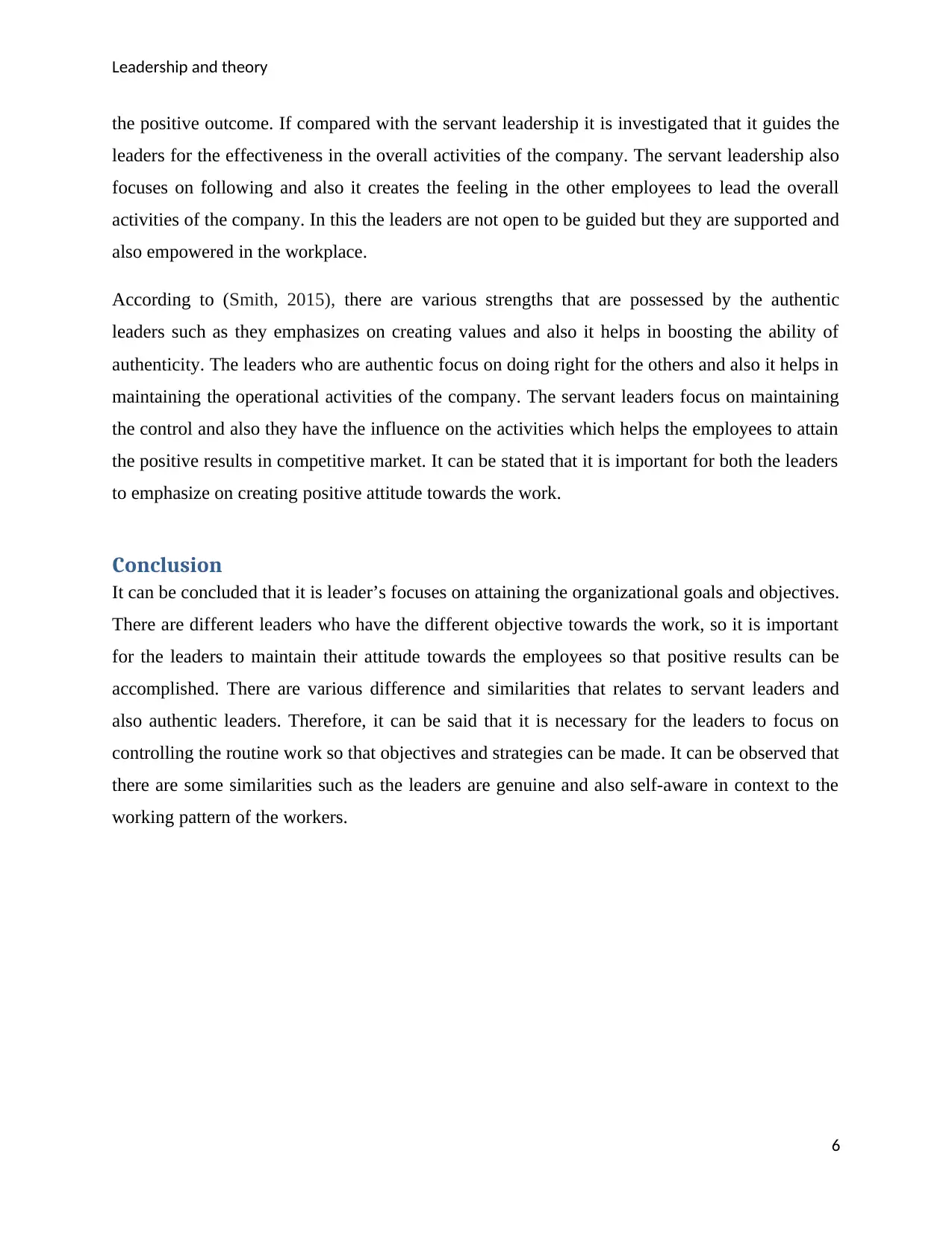
Leadership and theory
the positive outcome. If compared with the servant leadership it is investigated that it guides the
leaders for the effectiveness in the overall activities of the company. The servant leadership also
focuses on following and also it creates the feeling in the other employees to lead the overall
activities of the company. In this the leaders are not open to be guided but they are supported and
also empowered in the workplace.
According to (Smith, 2015), there are various strengths that are possessed by the authentic
leaders such as they emphasizes on creating values and also it helps in boosting the ability of
authenticity. The leaders who are authentic focus on doing right for the others and also it helps in
maintaining the operational activities of the company. The servant leaders focus on maintaining
the control and also they have the influence on the activities which helps the employees to attain
the positive results in competitive market. It can be stated that it is important for both the leaders
to emphasize on creating positive attitude towards the work.
Conclusion
It can be concluded that it is leader’s focuses on attaining the organizational goals and objectives.
There are different leaders who have the different objective towards the work, so it is important
for the leaders to maintain their attitude towards the employees so that positive results can be
accomplished. There are various difference and similarities that relates to servant leaders and
also authentic leaders. Therefore, it can be said that it is necessary for the leaders to focus on
controlling the routine work so that objectives and strategies can be made. It can be observed that
there are some similarities such as the leaders are genuine and also self-aware in context to the
working pattern of the workers.
6
the positive outcome. If compared with the servant leadership it is investigated that it guides the
leaders for the effectiveness in the overall activities of the company. The servant leadership also
focuses on following and also it creates the feeling in the other employees to lead the overall
activities of the company. In this the leaders are not open to be guided but they are supported and
also empowered in the workplace.
According to (Smith, 2015), there are various strengths that are possessed by the authentic
leaders such as they emphasizes on creating values and also it helps in boosting the ability of
authenticity. The leaders who are authentic focus on doing right for the others and also it helps in
maintaining the operational activities of the company. The servant leaders focus on maintaining
the control and also they have the influence on the activities which helps the employees to attain
the positive results in competitive market. It can be stated that it is important for both the leaders
to emphasize on creating positive attitude towards the work.
Conclusion
It can be concluded that it is leader’s focuses on attaining the organizational goals and objectives.
There are different leaders who have the different objective towards the work, so it is important
for the leaders to maintain their attitude towards the employees so that positive results can be
accomplished. There are various difference and similarities that relates to servant leaders and
also authentic leaders. Therefore, it can be said that it is necessary for the leaders to focus on
controlling the routine work so that objectives and strategies can be made. It can be observed that
there are some similarities such as the leaders are genuine and also self-aware in context to the
working pattern of the workers.
6
Paraphrase This Document
Need a fresh take? Get an instant paraphrase of this document with our AI Paraphraser
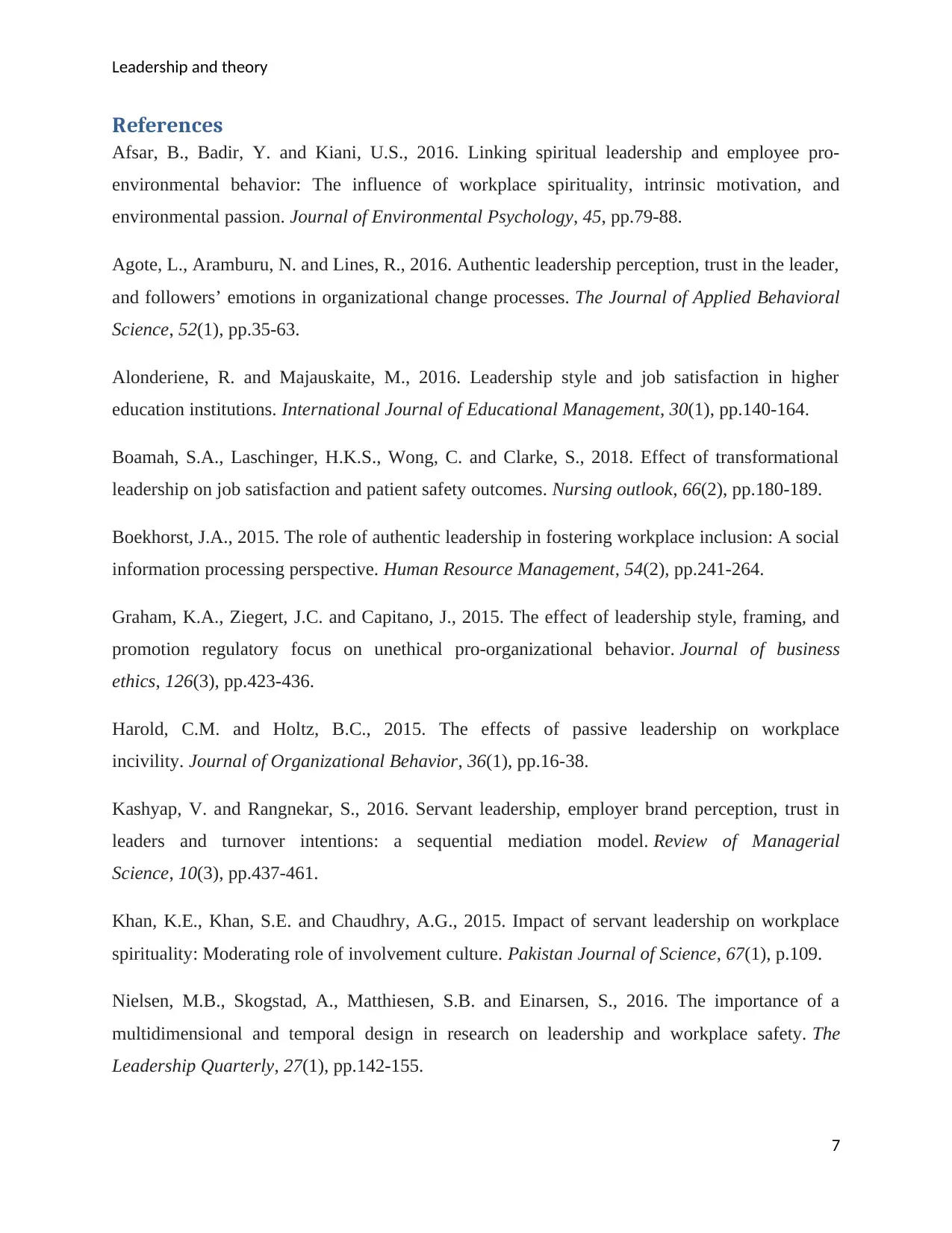
Leadership and theory
References
Afsar, B., Badir, Y. and Kiani, U.S., 2016. Linking spiritual leadership and employee pro-
environmental behavior: The influence of workplace spirituality, intrinsic motivation, and
environmental passion. Journal of Environmental Psychology, 45, pp.79-88.
Agote, L., Aramburu, N. and Lines, R., 2016. Authentic leadership perception, trust in the leader,
and followers’ emotions in organizational change processes. The Journal of Applied Behavioral
Science, 52(1), pp.35-63.
Alonderiene, R. and Majauskaite, M., 2016. Leadership style and job satisfaction in higher
education institutions. International Journal of Educational Management, 30(1), pp.140-164.
Boamah, S.A., Laschinger, H.K.S., Wong, C. and Clarke, S., 2018. Effect of transformational
leadership on job satisfaction and patient safety outcomes. Nursing outlook, 66(2), pp.180-189.
Boekhorst, J.A., 2015. The role of authentic leadership in fostering workplace inclusion: A social
information processing perspective. Human Resource Management, 54(2), pp.241-264.
Graham, K.A., Ziegert, J.C. and Capitano, J., 2015. The effect of leadership style, framing, and
promotion regulatory focus on unethical pro-organizational behavior. Journal of business
ethics, 126(3), pp.423-436.
Harold, C.M. and Holtz, B.C., 2015. The effects of passive leadership on workplace
incivility. Journal of Organizational Behavior, 36(1), pp.16-38.
Kashyap, V. and Rangnekar, S., 2016. Servant leadership, employer brand perception, trust in
leaders and turnover intentions: a sequential mediation model. Review of Managerial
Science, 10(3), pp.437-461.
Khan, K.E., Khan, S.E. and Chaudhry, A.G., 2015. Impact of servant leadership on workplace
spirituality: Moderating role of involvement culture. Pakistan Journal of Science, 67(1), p.109.
Nielsen, M.B., Skogstad, A., Matthiesen, S.B. and Einarsen, S., 2016. The importance of a
multidimensional and temporal design in research on leadership and workplace safety. The
Leadership Quarterly, 27(1), pp.142-155.
7
References
Afsar, B., Badir, Y. and Kiani, U.S., 2016. Linking spiritual leadership and employee pro-
environmental behavior: The influence of workplace spirituality, intrinsic motivation, and
environmental passion. Journal of Environmental Psychology, 45, pp.79-88.
Agote, L., Aramburu, N. and Lines, R., 2016. Authentic leadership perception, trust in the leader,
and followers’ emotions in organizational change processes. The Journal of Applied Behavioral
Science, 52(1), pp.35-63.
Alonderiene, R. and Majauskaite, M., 2016. Leadership style and job satisfaction in higher
education institutions. International Journal of Educational Management, 30(1), pp.140-164.
Boamah, S.A., Laschinger, H.K.S., Wong, C. and Clarke, S., 2018. Effect of transformational
leadership on job satisfaction and patient safety outcomes. Nursing outlook, 66(2), pp.180-189.
Boekhorst, J.A., 2015. The role of authentic leadership in fostering workplace inclusion: A social
information processing perspective. Human Resource Management, 54(2), pp.241-264.
Graham, K.A., Ziegert, J.C. and Capitano, J., 2015. The effect of leadership style, framing, and
promotion regulatory focus on unethical pro-organizational behavior. Journal of business
ethics, 126(3), pp.423-436.
Harold, C.M. and Holtz, B.C., 2015. The effects of passive leadership on workplace
incivility. Journal of Organizational Behavior, 36(1), pp.16-38.
Kashyap, V. and Rangnekar, S., 2016. Servant leadership, employer brand perception, trust in
leaders and turnover intentions: a sequential mediation model. Review of Managerial
Science, 10(3), pp.437-461.
Khan, K.E., Khan, S.E. and Chaudhry, A.G., 2015. Impact of servant leadership on workplace
spirituality: Moderating role of involvement culture. Pakistan Journal of Science, 67(1), p.109.
Nielsen, M.B., Skogstad, A., Matthiesen, S.B. and Einarsen, S., 2016. The importance of a
multidimensional and temporal design in research on leadership and workplace safety. The
Leadership Quarterly, 27(1), pp.142-155.
7
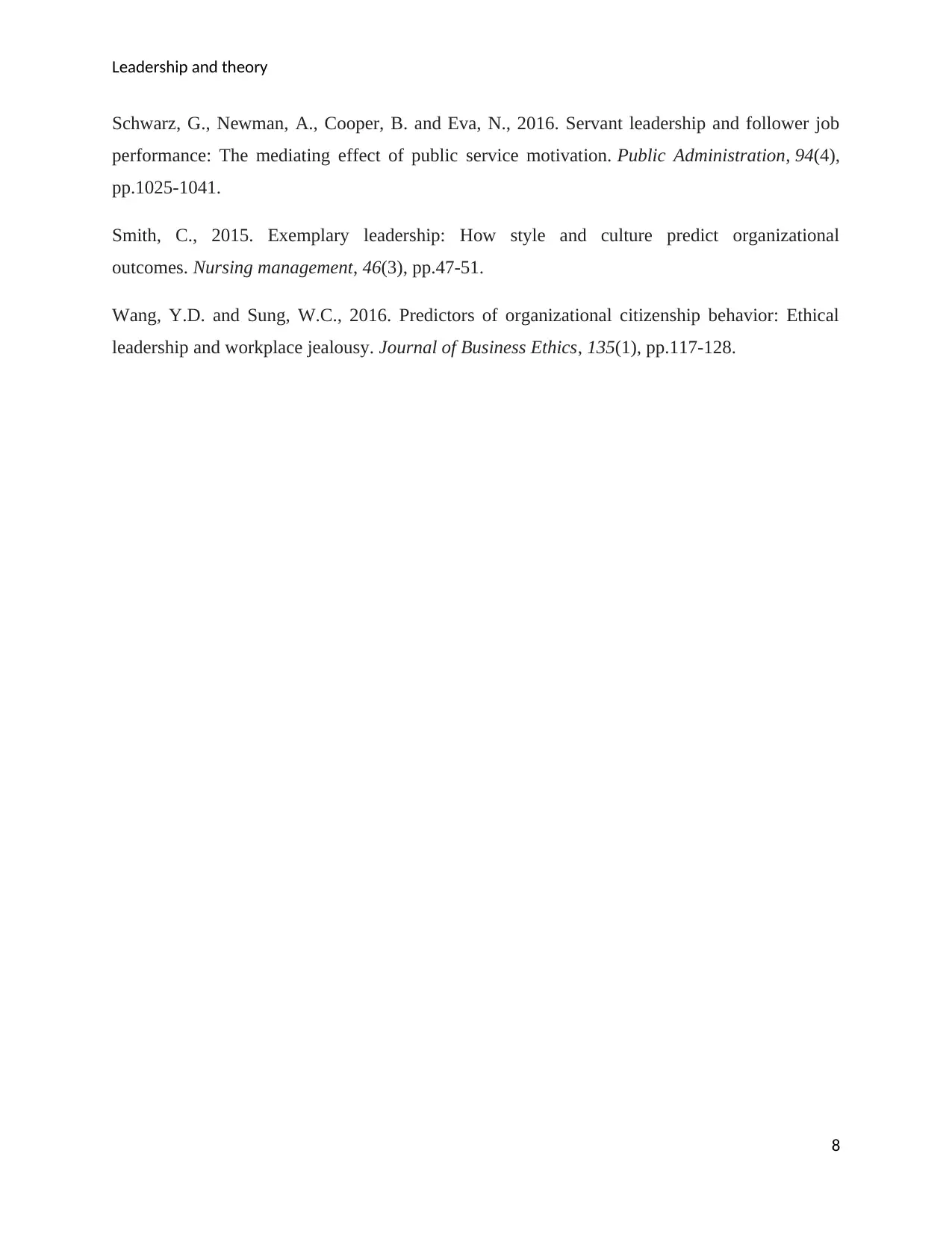
Leadership and theory
Schwarz, G., Newman, A., Cooper, B. and Eva, N., 2016. Servant leadership and follower job
performance: The mediating effect of public service motivation. Public Administration, 94(4),
pp.1025-1041.
Smith, C., 2015. Exemplary leadership: How style and culture predict organizational
outcomes. Nursing management, 46(3), pp.47-51.
Wang, Y.D. and Sung, W.C., 2016. Predictors of organizational citizenship behavior: Ethical
leadership and workplace jealousy. Journal of Business Ethics, 135(1), pp.117-128.
8
Schwarz, G., Newman, A., Cooper, B. and Eva, N., 2016. Servant leadership and follower job
performance: The mediating effect of public service motivation. Public Administration, 94(4),
pp.1025-1041.
Smith, C., 2015. Exemplary leadership: How style and culture predict organizational
outcomes. Nursing management, 46(3), pp.47-51.
Wang, Y.D. and Sung, W.C., 2016. Predictors of organizational citizenship behavior: Ethical
leadership and workplace jealousy. Journal of Business Ethics, 135(1), pp.117-128.
8
⊘ This is a preview!⊘
Do you want full access?
Subscribe today to unlock all pages.

Trusted by 1+ million students worldwide
1 out of 9
Related Documents
Your All-in-One AI-Powered Toolkit for Academic Success.
+13062052269
info@desklib.com
Available 24*7 on WhatsApp / Email
![[object Object]](/_next/static/media/star-bottom.7253800d.svg)
Unlock your academic potential
Copyright © 2020–2025 A2Z Services. All Rights Reserved. Developed and managed by ZUCOL.





